Introduction
In the dynamic landscape of business intelligence, the choice between Power BI and SQL Server Reporting Services (SSRS) can significantly impact an organization’s reporting capabilities and overall efficiency. As companies strive to harness data for strategic advantage, understanding the unique strengths of each tool is crucial.
- Power BI, with its cloud-based flexibility and user-friendly interface, empowers teams to create interactive reports and dashboards that foster a culture of data-driven decision-making.
- On the other hand, SSRS offers a robust solution for traditional reporting needs, emphasizing precision and detailed operational insights.
However, the transition from SSRS to Power BI is not without its challenges, including data compatibility and user training. By exploring deployment options, integration capabilities, and the potential of combining these tools with Robotic Process Automation (RPA), organizations can navigate their reporting journeys more effectively.
This article delves into the nuances of Power BI and SSRS, providing practical insights to help organizations make informed decisions that align with their specific reporting goals.
Introduction to Power BI and SQL Server Reporting Services (SSRS)
BI reporting services and SQL Server Reporting Services (SSRS) are integral tools in the realm of business intelligence reporting, each offering unique advantages tailored to specific organizational needs. BI, a cloud-based service from Microsoft, enables users to visualize information and share insights effortlessly across different tiers of an organization. Its interactive dashboards and customizable reports facilitate a dynamic approach to analytics, fostering a culture of evidence-based decision-making.
However, utilizing insights from Business Intelligence can pose challenges, such as time-consuming report creation, inconsistencies, and a lack of actionable guidance. According to a survey by MicroStrategy, 88% of organizations utilizing cloud-based BI indicated enhanced flexibility in accessing and analyzing data from any location, at any time, highlighting Power BI’s benefits in contemporary analysis environments. In contrast, the server-based solution stands as a robust tool that enables the creation, deployment, and management of documents with precision.
Both tools fulfill similar objectives but are designed to accommodate different documentation structures and organizational frameworks. As organizations aim to improve their documentation capabilities, comprehending the functionalities and applications of BI reporting services and SSRS becomes essential. Significantly, the BFSI sector is set for swift expansion in business intelligence tools from 2023 to 2032, indicating a heightened demand for efficient analysis solutions.
Additionally, significant markets such as China, Japan, and the United Kingdom contribute 12.95%, 6.77%, and 4.78% respectively to the BI landscape, further emphasizing the global relevance of these tools. With BI’s growing use—apparent from recent statistics indicating its dominance in the market—the decision between these tools ultimately depends on the specific analysis needs and objectives of the organization. Moreover, grasping the kinds of changes organizations need to handle during the execution of information and BI solutions, as emphasized in the case study on ‘Types of Change to Manage in Fabric Adoption,’ is crucial for effective integration and enhancing the advantages of these analytical solutions.
Embracing RPA alongside BI can significantly enhance operational efficiency, ultimately driving business growth. EMMA RPA provides advanced automation features that streamline repetitive tasks, while Automate simplifies workflows, ensuring that organizations can efficiently manage their data processes. Failing to adopt these BI tools can leave organizations at a competitive disadvantage, underscoring the urgency for Directors of Operations Efficiency to prioritize these technologies.
A proactive strategy for integrating BI and RPA can not only reduce challenges in documentation but also encourage a culture of continuous improvement and innovation.
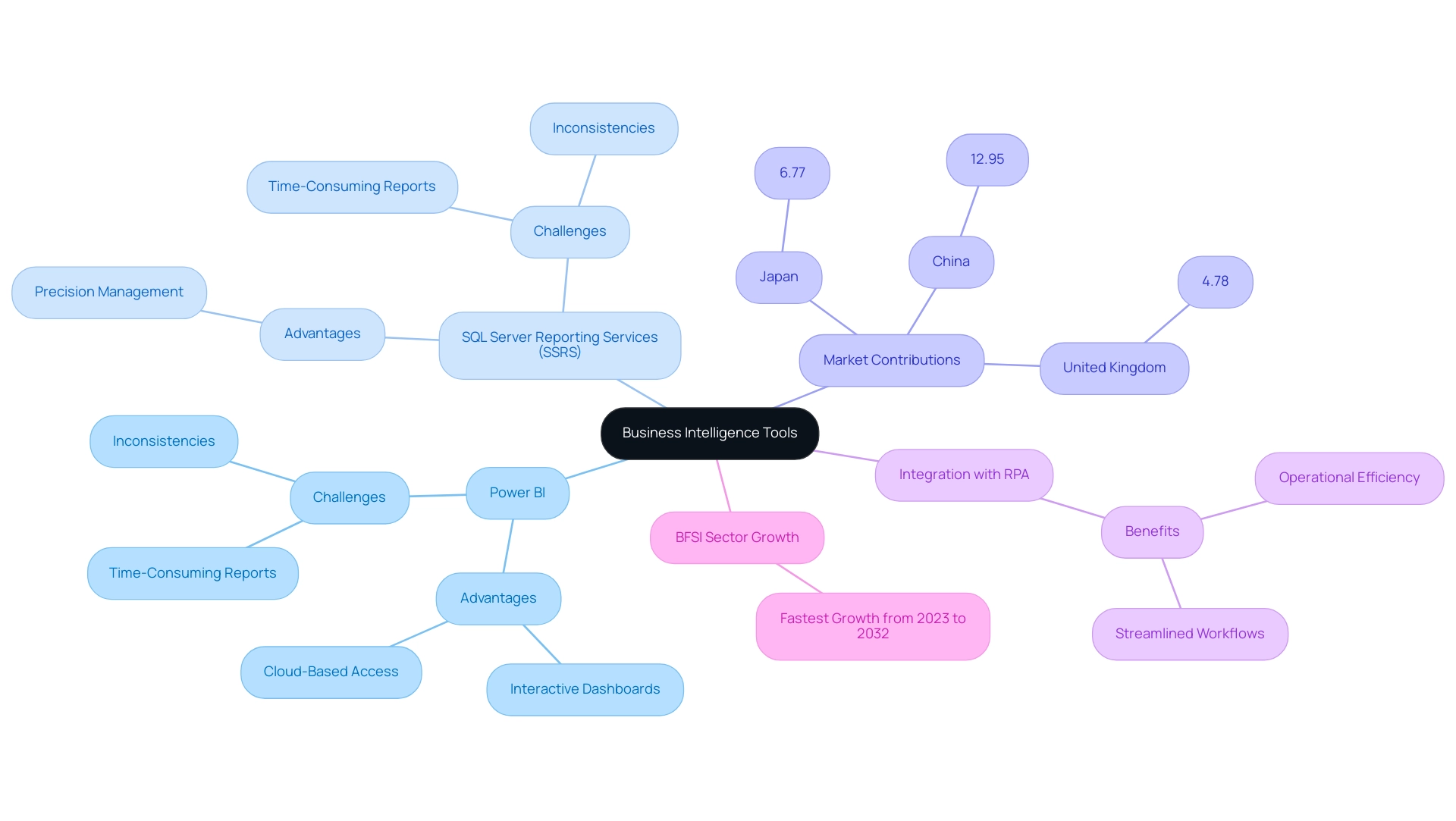
Key Differences Between Power BI and SSRS
Comprehending the main differences between BI reporting services and SSRS is crucial for enhancing your reporting strategy. Power BI stands out as a solution for self-service analytics, enabling users to independently create dynamic reports and dashboards with minimal technical assistance. Its emphasis on visualization and interactivity enhances the user experience, making insights more accessible.
However, challenges such as time-consuming report creation, inconsistencies, and a lack of actionable guidance can impede its effectiveness. As emphasized in our BI reporting services, we offer a 3-Day BI Sprint to swiftly develop professionally crafted documents, along with a General Management App for thorough management and insightful evaluations, ensuring effective documentation and data consistency. Additionally, our actions portfolio provides a structured approach to implementing these solutions effectively.
In contrast, the system is tailored for traditional reporting, emphasizing paginated reports that are crucial for operational needs. This tool demands a higher level of technical expertise for setup and management, which can be a barrier for some users. As noted by an anonymous user,
When we run scheduled jobs to email reports, jobs are executing successfully, but we don’t receive any reports.
This emphasizes the significance of tackling these challenges in utilizing insights from BI dashboards. Furthermore, PBIRS, which merges BI report server and another reporting server, requires a SQL Server Volume license or separate acquisition, adding complexity to the decision-making process for organizations. For those aiming for quick insights and user-friendly interfaces, BI, particularly with our tailored solutions, is often the preferred choice.
However, for those needing precise formatting and detailed operational reports, this tool may still hold significant value. A case study titled ‘Choosing Between Power BI and SSRS’ reveals that aligning the tool with specific business needs is critical; Power BI excels in dynamic analysis while SSRS remains a strong contender for static requirements. By assessing these differences and utilizing our expertise, organizations can make informed decisions that align with their objectives.
To explore how our solutions can enhance your reporting strategy, we invite you to book a free consultation.
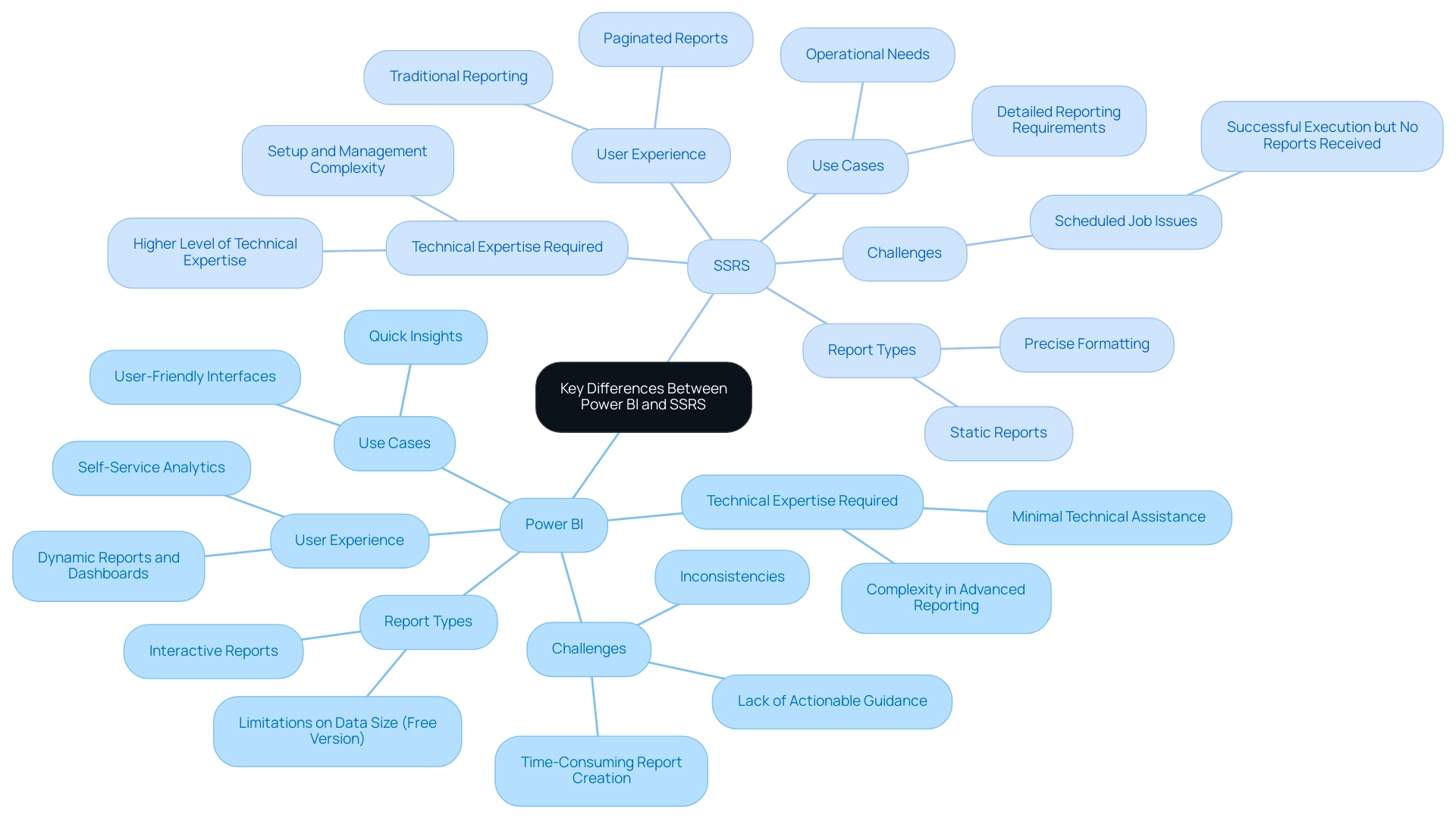
Challenges in Migrating from SSRS to Power BI
Transitioning from SQL Server Reporting Services to Business Intelligence, particularly focusing on BI reporting services, can present a complex journey, often marked by notable challenges such as:
- Data compatibility issues during the integration of existing reporting services with Business Intelligence’s advanced data models.
- Query time-out values for embedded datasets, which are specified during report authoring and stored in the report definition.
As users who are accustomed to SSRS navigate the interface of BI reporting services, they may require substantial training to effectively leverage its full range of features.
As Paul Turley, a Microsoft Data Platform MVP, highlights,
Same best practice guidelines… different scale, and different focus,
underscoring the need for tailored strategies in adapting to new platforms.
To overcome these challenges, organizations should first conduct a comprehensive assessment of their information requirements, including the identification of suitable AI solutions that align with their specific business needs. Investing in user training is essential, empowering team members to utilize BI proficiently.
Moreover, incorporating Robotic Process Automation (RPA) can streamline workflows, reducing the burden of manual tasks during this transition. Furthermore, adopting a phased migration approach can significantly reduce disruptions, allowing for a smoother transition and the realization of BI reporting services’ powerful capabilities. By embracing these strategies, organizations can harness the benefits of Business Intelligence, particularly when building new reports or starting from scratch, while effectively addressing the migration challenges, including potential data inconsistencies and the time-consuming nature of report creation, thus enhancing operational efficiency.
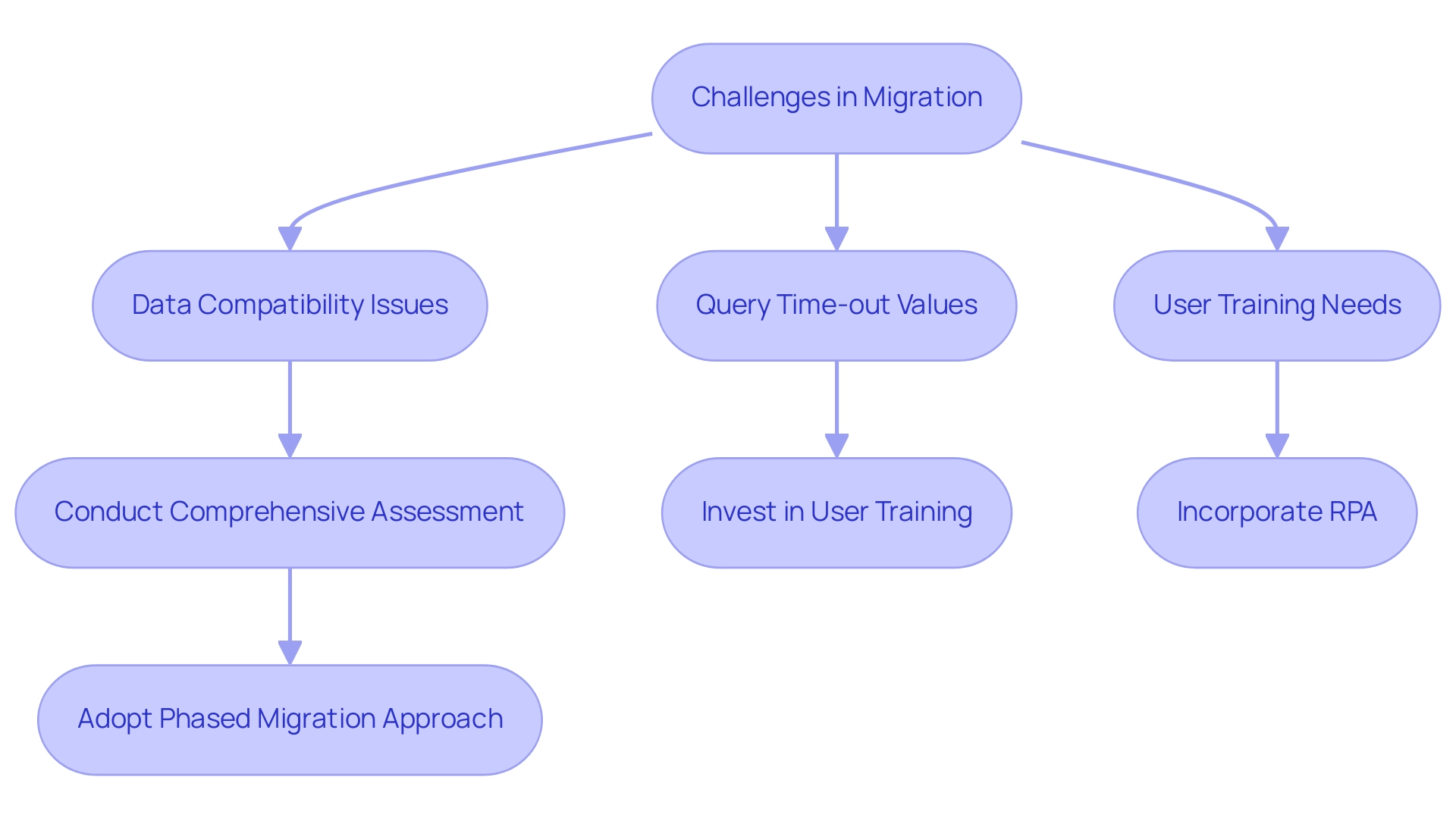
Deployment Options: On-Premises vs. Cloud for Power BI and SSRS
Power BI reporting services provide a variety of deployment options, allowing organizations to select between cloud-based solutions and on-premises installations via Power BI Report Server. The cloud version not only facilitates automatic updates but also enhances collaborative efforts by providing seamless access to shared dashboards. Conversely, SQL Server BI reporting services have traditionally been implemented on-premises, giving organizations full control over their reporting environments.
However, a significant shift is underway as Microsoft introduces cloud capabilities for SSRS, enabling BI reporting services through hybrid deployment models that harness the strengths of both approaches. Given that half of surveyed businesses view cloud computing as crucial for their data protection strategy, decision-makers must weigh the benefits of cloud scalability against the control offered by on-premises solutions. Notably, the U.S. and Western Europe represent 82% of global cloud computing, illustrating regional trends in cloud adoption.
This strategic evaluation will guide organizations in selecting the deployment option for BI reporting services that best meets their operational needs and objectives. The right configuration in BI can empower teams with actionable insights for smarter decision-making, highlighting the critical importance of choosing an appropriate deployment strategy. As Amit Chandak highlighted at the Microsoft Analytics Community Conference, global leaders are sharing insights to enable users in mastering the latest technologies, including deployment choices for BI reporting services.
Moreover, utilizing RPA tools like EMMA RPA and Automate can simplify processes by tackling task repetition fatigue and staffing shortages, further easing the challenges of report creation and information inconsistencies. This integration of BI and RPA not only drives business growth and innovation but also mitigates the competitive disadvantage that arises from failing to utilize data-driven insights effectively.
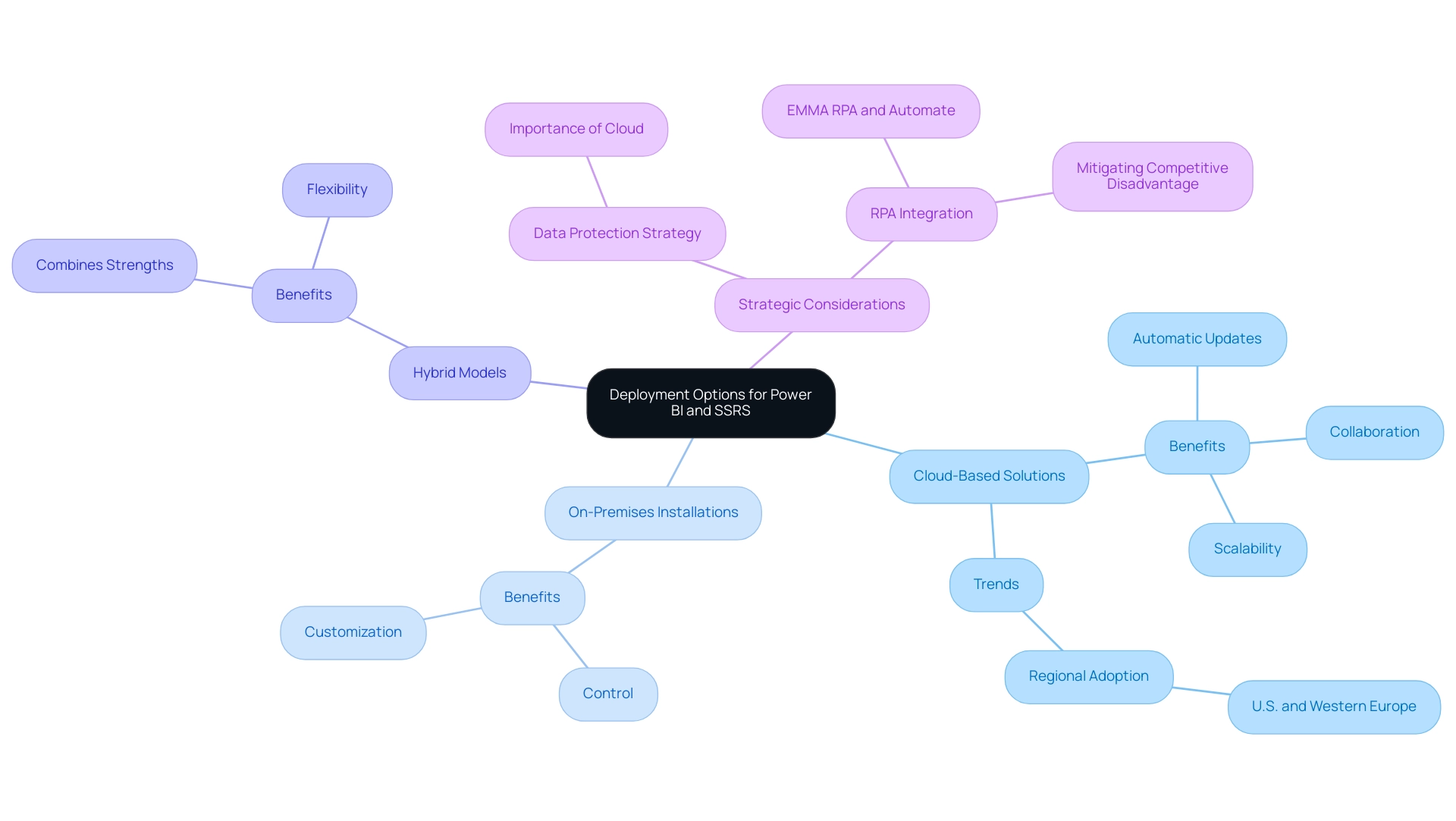
Integration Capabilities of Power BI and SSRS
BI reporting services and SSRS offer strong integration capabilities that are essential for organizations aiming to enhance their reporting and analytics. BI stands out with its seamless connectivity to cloud services, databases, and Excel files, enabling users to effortlessly combine information from diverse platforms. This capability has significantly contributed to BI’s popularity, with over 5 million customers leveraging its versatile integration options to drive data-driven insights.
Notably, Power BI’s features such as real-time information access and interactive dashboards directly address challenges like time-consuming report creation and inconsistencies. On the other hand, while the reporting service has typically concentrated on SQL Server information, it offers the adaptability to link to further sources through custom processing extensions. Recent updates have enhanced reporting source connections, ensuring a seamless flow of information across systems.
Enhancements such as High DPI scaling support in Report Builder and accessibility options for text box properties exemplify how SSRS is evolving to meet diverse user needs. Furthermore, integrating RPA solutions like EMMA RPA and Power Automate can streamline data processing tasks, further enhancing operational efficiency. By understanding these integration strengths and improvements, organizations can significantly enhance their BI reporting services, ultimately driving more informed decision-making and operational efficiency.
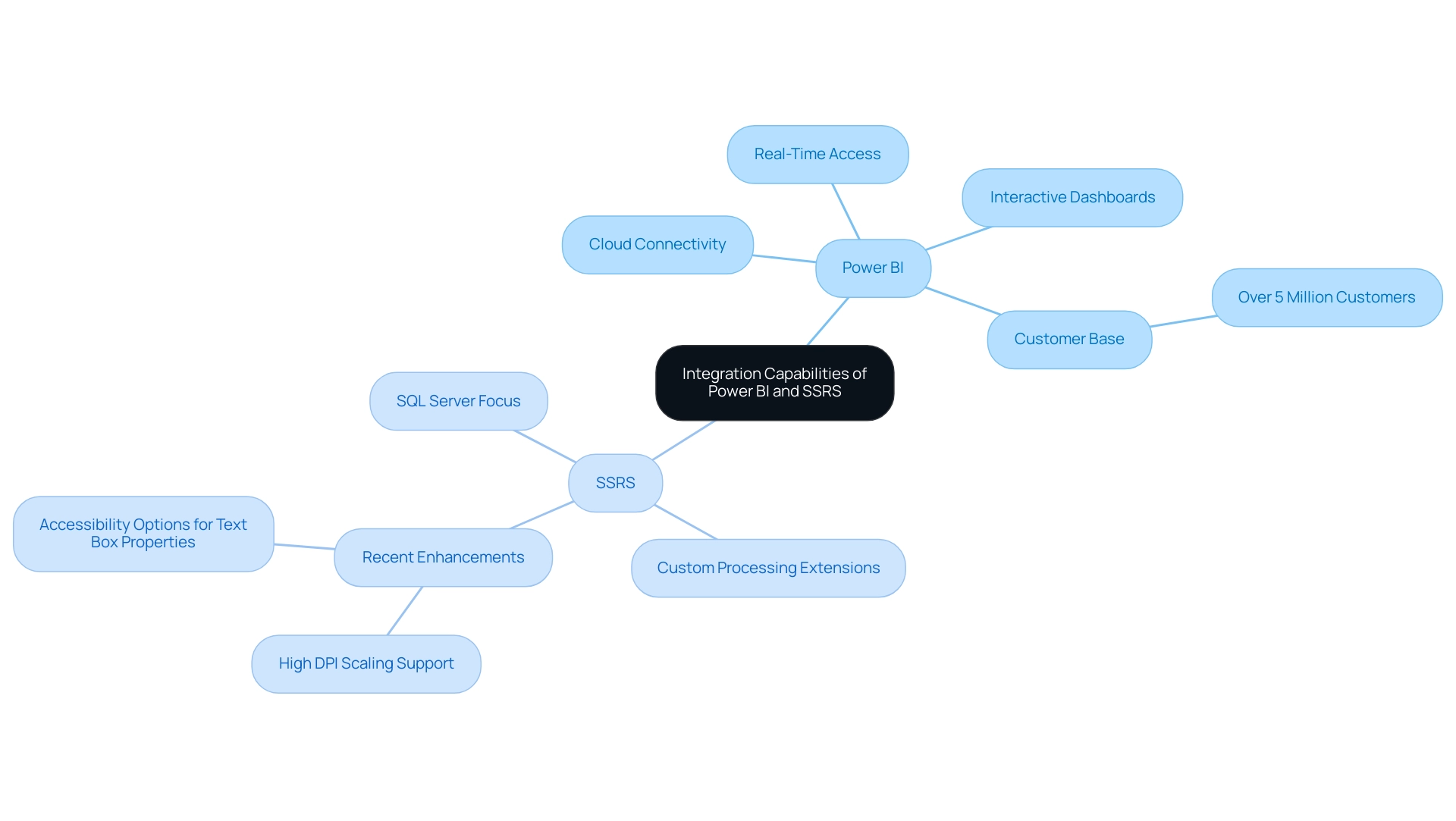
Conclusion
The comparison between Power BI and SQL Server Reporting Services (SSRS) highlights the critical choices organizations must make in their business intelligence strategies. Power BI offers cloud-based flexibility and interactive reporting features that foster data-driven decision-making. However, organizations must tackle challenges like time-consuming report creation and data inconsistencies to maximize its benefits.
On the other hand, SSRS remains a robust solution for traditional reporting, focusing on precision and operational insights. While it requires more technical expertise, its capability to generate detailed paginated reports is invaluable for organizations prioritizing accuracy. The transition from SSRS to Power BI can be challenging but presents an opportunity to improve reporting efficiency when managed strategically.
Considering deployment options is also vital, as organizations must balance the benefits of cloud scalability with the control of on-premises solutions. Additionally, integrating Robotic Process Automation (RPA) can streamline workflows and reduce the burden of manual tasks, enhancing overall operational efficiency.
Ultimately, selecting the right tool—whether Power BI or SSRS—should align with specific reporting goals and organizational needs. By understanding the unique strengths and challenges of each option and leveraging solutions like RPA, organizations can enhance their reporting capabilities and drive growth in a data-driven landscape. Prioritizing these technologies is essential for maintaining a competitive edge in today’s rapidly evolving business environment.

